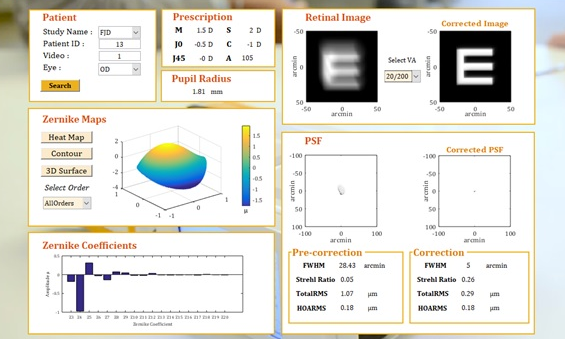Development of wavefront aberrometry features based on dynamic information

| AUTHORS / CAREER / CENTER | Andrea Gil Ruiz/ Biomedical Engineering / Universidad Carlos III de Madrid |
| SUPERVISORS | Eduardo Lage / PhD / Universidad Autonoma de Madrid
Marcos Rubio Rubio |
| TYPE | Bachelor Thesis |
| ABSTRACT | Motivation: Uncorrected refractive errors affect more than one billion people worldwide because of the limited access to eye care in low-resource settings. Inaccessibility to an eyeglass prescription in developing countries is mainly caused by the shortage of qualified professionals. Our research group in Universidad Autónoma de Madrid, together with the company PlenOptika Inc (USA) introduced a novel handheld open-view autorefractor called QuickSee (QS). The device uses a wavefront sensing approach, avoiding expensive components and it is able to accurately provide eyeglass prescriptions in only 10 seconds. Its ease of use allows minimally-trained personnel to perform refraction. This works explores the possibility of using complete dynamic wavefront information (low- and high-order aberrations and time) to further improve the accuracy of the device and expand its capabilities. Problem Statement: The current software in the QS includes an accommodation detection function, but it is not able to recognize many clear cases of this reflex action of the eye. As a result, non-identified cases of accommodation show a more myopic final prescription than they should. In this way, the first specific objective in this work is aimed at the optimization of the current accommodation software.Furthermore, the addition of new functionalities to the binocular QS is expected to translate the device into a new premium QS version in developed countries. The second goal of the work is to test the ability of the QS to measure higher order aberrations, together with the development of the basic functions required for an Aberrometry Module Interface.
Approach: In order to improve the accuracy of the accommodation detection function a new region-based algorithm has been developed and validated in a cohort of previously acquired patients (183 subjects, 5-65 years old) for which raw data and subjective refraction was available. On the other hand, a statistical analysis has been performed to compare the ability to measure High Order Aberrations (HOAs) with the QS technology and a high-end wavefront autorefractor, 3.8 VISX WaveScan, (50 subjects, 18-65 years old). Moreover, new functionalities based on Fourier Optics able to represent wavefront maps and retinal images have been implemented.
Results: The new accommodation algorithm detects a 100% of accommodation cases in which the prescription is improved in both, adults and children. It has reduced the absolute average error of the power vector M by a 42.9%. Additionally, the percentage point (pp) difference in % HOAs between the two aberrometers is only 5.58 pp and the averaged absolute difference in the overall RMS in microns is a 22,5% bigger for the QS. Moreover, the QS has shown a high sensitivity to the alignment of the laser with the user’s pupil.
Conclusion: the new accommodation software has been optimized and has reduced the absolute average error of the power vectors. The capacity to measure HOAs with the QuickSee has also been proved. Besides, the first version of the Aberrometry Module Interface is an intuitive tool able to successfully provide a detailed description of each optical aberration.
Key Words: autorefractor, QuickSee, wavefront aberrometry, High-order Aberrations, refractive errors, accommodation, optimization, user interface. |
| LINK | Confidential content |



